Novel photoinitiators based on difluoroborate complexes of squaraine dyes for radical polymerization of acrylates upon visible light†
Abstract
The present article describes the efficiency of novel two-component photoinitiators based on a typical squaraine dye and its difluoroborate analogues for the radical polymerization of acrylate monomers. The role of photosensitizers in photoinitiating systems was played by squaraine derivatives, such as 2,4- bis (3,5-dimethylpyrrol-2-yl)squaraine (PSQ1) and 2,4- bis (4-ethyl-3,5-dimethylpyrrol-2-yl)squaraine (PSQ2) and difluoroborate complexes of these compounds, such as BPSQ1 and BPSQ2, named BODIPY dyes. These dyes absorb radiation in visible region of the spectrum, from 400 nm to 600 nm and show high molar absorption coefficients of about 105 dm3 mol−1 cm−1. Therefore, they may be used as sensitizers, e.g. in photopolymerization experiments. The synthesized dyes were combined with various co-initiators and used as visible-light photoinitiators for the radical polymerization of 2-ethyl-2-(hydroxymethyl)-1,3-propanediol triacrylate (TMPTA). The proposed systems show different photoinitiation abilities, which are related to the structure of both sensitizer and co-initiator and the concentration of applied photoinitiator. Novel derivatives of squaric acid could be the starting point for the design of new photoinitiating systems for radical and cationic polymerization based on squaraine dyes.

- This article is part of the themed collection: Photopolymer science


 Please wait while we load your content...
Please wait while we load your content...